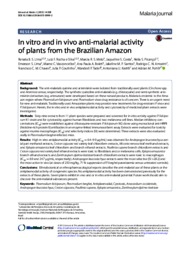In vitro and in vivo anti-malarial activity of plants from the Brazilian Amazon.
In vitro and in vivo anti-malarial activity of plants from the Brazilian Amazon.
Summary: The anti-malarials quinine and artemisinin were isolated from traditionally used plants (Cinchona spp. and Artemisia annua, respectively). The synthetic quinoline anti-malarials (e.g. chloroquine) and semi-synthetic artemisinin derivatives (e.g. artesunate) were developed based on these natural products. Malaria is endemic to the Amazon region where Plasmodium falciparum and Plasmodium vivax drug-resistance is of concern. There is an urgent need for new anti-malarials. Traditionally used Amazonian plants may provide new treatments for drug-resistant P. vivax and P. falciparum. Herein, the in vitro and in vivo antiplasmodial activity and cytotoxicity of medicinal plant extracts were investigated.
Publication year: 2015
Types of publication: Journal article
Unit: Embrapa Western Amazon
Observation
Some of Embrapa's publications are published as ePub files. To read them, use or download one of the following free software options to your computer or mobile device. Android: Google Play Books; IOS: iBooks; Windows and Linux: Calibre.
Access other publications
Access the Agricultural Research Database (BDPA) to consult Embrapa's full library collection and records.
Visit Embrapa Bookstore to purchase books and other publications sold by Embrapa.

